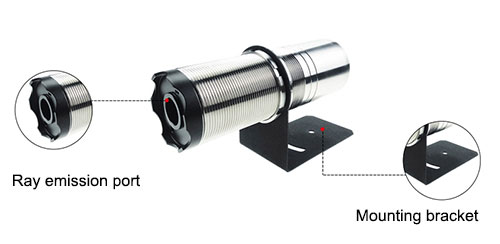What is a Temperature Sensor?
A temperature transducer is a sensor that senses temperature and converts it into a usable output signal. It converts temperature information into electrical signals or digital data to monitor, control, and record temperature changes. Temperature sensors play an important role in a variety of applications, from industrial automation to household appliances, from medical equipment to weather forecasting, all need reliable temperature measurement. ATO store will introduce the structure, working principle, application areas, and development status of temperature sensors in detail.
Structure
- Temperature-sensitive Element: The temperature-sensitive element is the core of a temperature sensor and changes its electrical or mechanical properties in response to changes in temperature. Different types of temperature sensors use different sensitive elements. Some common sensitive elements include thermistors, thermocouples, and thermal capacitance sensors.
- Connecting Cables or Wires: This is the part that connects the temperature sensor to the data acquisition device or control system. The cable or wire is used to transmit the signals from the temperature-sensitive element.
- External Protective Housing: Temperature sensors usually require external housing to protect the sensitive elements from environmental factors such as humidity, dust, and chemicals.
- Connector or Connector: A connector or connector is used to connect a temperature sensor to a measuring device or control system. It usually contains plugs and sockets to ensure proper connection.
- Signal Processing Circuitry (sometimes): Some temperature sensors require built-in signal processing circuitry to convert the sensor's output signal to a digital or standard voltage signal for easier integration with other devices.
- Positioning Devices (sometimes): Some temperature sensors require special mounting or positioning devices to ensure that the temperature sensor can accurately measure temperature.

Principle of Operation
Sensors designed on the principle of metal expansion: Metals produce a corresponding extension in response to changes in ambient temperature, so temperature sensors can signal this reaction in different ways.
- Bimetal Sensors: A bimetal consists of two pieces of metal with different coefficients of expansion stuck together. As the temperature changes, material A expands more than the other metal, causing the metal piece to bend. The curvature of the bend can be converted into an output signal.
- Bimetallic Rod and Tube Sensors: As the temperature rises, the length of the metal tube (material A) increases, while the length of the non-expanding steel rod (metal B) does not, so that the linear expansion of the metal tube can be transmitted due to the change in position. In turn, this linear expansion can be converted into an output signal.
- Sensors Designed for the Deformation Curves of Liquids and Gases: During temperature changes, liquids and gases likewise produce a corresponding volume change. Various types of structures can convert this change in expansion into a change in position, which produces a change in position output (potentiometers, sensing deviations, flow stops, etc.).
- Resistance Sensing: As a metal changes temperature, the resistance of the temperature sensor changes. For different metals, the resistance value changes differently for each degree of temperature change, and the resistance value can be used directly as an output signal.

Development
In recent years, China's industrial modernization process and the electronic information industry's continuous high-speed growth led to a rapid rise in the sensor market. Temperature sensors as an important category of sensors, accounting for more than 40% of the total demand for the entire sensor. Temperature sensors are semiconductor devices that utilize the resistance of NTC to change with temperature to convert non-electrical physical quantities into electrical quantities for precise temperature measurement and automatic control.
Temperature sensor use is very broad, can be used as temperature measurement and control, temperature compensation, flow rate, flow and wind speed determination, liquid level indication, temperature measurement, ultraviolet and infrared light measurement, microwave power measurement, etc., and is widely used in color TV, computer color monitor, switching power supply, water heater, refrigerator, kitchen equipment, air conditioning, automotive and other fields. In recent years, the rapid growth of the automotive electronics, and consumer electronics industry has led to the rapid growth of demand for temperature sensors in China.
Application Areas
- Industrial Automation: In industrial processes, high quality temperature sensors are used to monitor and control the temperature to ensure the stability and safety of the production process.
- Medical Equipment: Medical equipment such as thermometers, surgical instruments, and laboratory equipment require accurate temperature measurement.
- Weather Forecasting: Weather stations use temperature sensors to measure air temperature, which is key data for predicting weather and climate change.
- Household Appliances: Household appliances such as stoves, refrigerators, and air conditioners use temperature sensors to control temperature and operation.
- Automotive Industry: Temperature sensors are used to monitor engine temperatures, cooling systems, and emissions control.
- Food Processing and Storage: In food processing and storage, temperature sensors help ensure that food is kept and cooked at safe temperatures.
Temperature sensors play an important role in modern life. Temperature sensors play an important role in a variety of industries, helping to improve efficiency, ensure safety, and drive innovation. With a wide range of applications, temperature sensors are an important part of modern technology and engineering. In the future, as technology continues to evolve, temperature sensors will become even more advanced, and versatile and bring even more innovation to a variety of fields.

